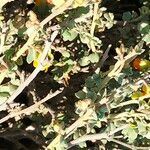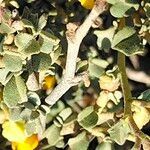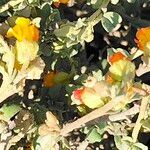Suffrutex, usually heavily browsed, varying in height from 15-90 cm tall, rigid, erect or spreading, much branched, branchlets very sparsely to very densely lepidote-stellate and then silvery grey in appearance. Stipules from small and subulate from a broad base to broadly ovate in upper parts of plant, base broad and sometimes subcordate, apex acute or acuminate, up to about 3.5 mm long and 3.5 mm broad at base, pubescence as on leaves but with a few long hairs at apex or also on margin near apex. Leaves appearing fascicled when crowded on abbreviated shoots, shortly petiolate; blade dull grey-green to silvery grey, concolorous, cuneate, from about 6-18 mm long, 3-10 mm broad at apex, truncate, bi-lobed or broadly rounded and coarsely crenately lobed at apex, sometimes conduplicate, upper and lower surfaces from sparsely to densely tomentose with fringed pitted scales (lepidote-stellate), lateral nerves usually obscure; petiole 1-9 mm long. Inflorescence a raceme of secund, 1-2-flowered cymes terminal on ultimate branchlets, or cymes 3-5 congested at apices of short, lateral branchlets; peduncles very short (1 mm long) and spreading or about 4 mm long and then strictly erect; bracts 2-3 or more at a node and sometimes with an entire, elliptic bract among them, broadly ovate, usually about 3-4 mm long, 2-4, 5 mm broad at base, semi-amplexicaul, sometimes united, cucullate, sometimes with bristle-like hairs on margins and apex; pedicels 1-5 mm long, cernuous. Calyx campanulate, about 6 mm long, lobed to about one third the length, laxly to very densely lepidote-stellate, the scales and hairs straw-coloured or some light reddish brown. Petals bright yellow to dark orange-red, up to about 5-10 mm long, narrowed at base into a claw, claw glabrous to densely pubescent along margins, lower portion with inrolled margins. Stamens with hyaline, oblong-obovate filaments, a few hairs on shoulders; anthers 3 mm long, pointed, ciliate. Ovary densely lepidote-stellate (hairs short), shallowly 5-lobbed, shortly stipitate; stipe 1 mm long; styles about 5 mm long. Capsule lepidote-stellate, about 7 mm long.
More
Rigid suffrutex, 0.3-0.9 m high; covered by pitted, fringed scales, giving plant a silvery appearance. Leaves appearing fascicled, shortly petiolate; cuneate, often folded, apex rounded or truncate, coarsely crenate; sparsely to densely tomentose with fringed, pitted scales on both surfaces. Stipules subulate to broadly ovate. Inflorescences: racemes of secund 1-or 2-flowered cymes on ultimate branchlets or 3-5 congested cymes terminal on short, lateral branchlets; peduncles and pedicels short. Flowers 5-10 mm long, yellow to orange-red. Calyx campanulate, 5-lobed in upper 1/3; sparingly to densely covered by fringed, pitted scales. Petals ± twice as long as calyx, contorted, narrowing into a claw. Flowering time all year. Fruit a lepidote-stellate capsule.
Roughly scaly, twiggy shrub, up to 1 m tall. Leaves cuneate, coarsely toothed above, sometimes appearing clustered. Flowers 1 or 2, turned to one side on branch tips or 3-5 clustered at tips of short lateral branches, yellow often fading reddish, sweetly scented.
Roughly scaly, twiggy shrub to 1 m. Leaves cuneate, coarsely toothed above, sometimes appearing fascicled. Flowers on subsecund racemes, yellow often fading reddish.



